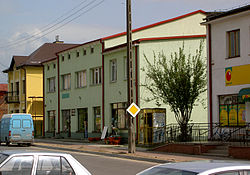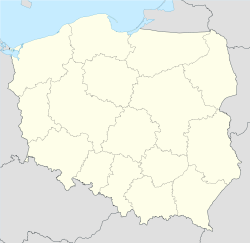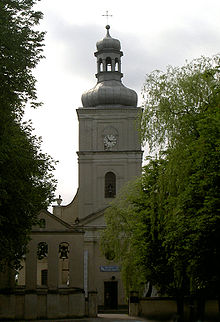- Narol (town)
-
Narol Market square, Narol 
Coat of armsCoordinates: 50°21′1″N 23°19′38″E / 50.35028°N 23.32722°E Country  Poland
PolandVoivodeship Subcarpathian County Lubaczów Gmina Narol Government - Mayor Stanisław Andrzej Woś Area - Total 12.4 km2 (4.8 sq mi) Population (2006) - Total 2,120 - Density 171/km2 (442.8/sq mi) Time zone CET (UTC+1) - Summer (DST) CEST (UTC+2) Postal code 37-610 Car plates Website http://www.narol.pl/ Narol [ˈnarɔl] is a town in Podkarpacie Voivodeship, in Lubaczów County, Poland. It had a population of 2,109 as of 2009.[1] Narol is situated in the northeast of Podkarpackie region, in an area called Narolschyzna. The town of Narol regained the rank of 'city' in 1996.
Contents
History
The Belzhecki family owned the area where the town of Narol is situated. At the end of the 15th century the lands changed ownership to the Marcinkowski. Narol was first called Florianow, from the name of Florian Laszcz Nieledowski, who founded the town in 1596. Narol flourished because of trade with Gdańsk.
The army of the cossack Bohdan Khmelnytsky (c. 1595-1657) attacked the town on their way to Zamość. After a few days of siege, the town was overrun and burned to the ground by Khmelnytsky's forces. Twenty thousand people died during those fights, among them Florian Washch, the owner of the town. A new town was built, somewhat west of the original location, "on a field" - hence "na roli". The new settlement assumed the new name Narol. In 1672 a great Hetman, Jan Sobieski, won a battle with the Tatars nearby. Later Sobieski became the Polish king.
Count Los`
In 1758 Felix Anthony Los` (1737–1804) became the owner of Narol and a deputy and a general of the king's army. He opened a factory and a school in Narol. In 1776, he began construction a palace in the form of a horseshoe (the Los's coat of arms).
Near the palace there was an Italian garden. Count Los` was an avid collector of old writings, correspondence and manuscripts, and paintings of the Italian and Dutch schools. He accumulated one of the largest libraries in Poland at that time. He founded a drama and music school for children from more affluent families. That was located on premises of the palace. The palace was considered one of the most beautiful in the whole country. After his death all of the collection was lost, with most of the library ending up in the hands of Count Jacob Potocki. In 1935 the books were donated to a public library in Warsaw.
Recent events
During the January Uprising (1863), the Palace in Narol was burnt by the Austrian army. Julian Puzyna, its later owner, rebuilt, but during World War I Narol was burnt again and all the valuable things in the palace were removed by the Russian Army. The last owner was Jadwiga Korytowska. She rebuilt parts of the palace, and owned it until September 1939. During World War II a small German Wehrmacht detachment was stationed in the palace.
After World War II the palace was robbed and destroyed by Red Army. The land was nationalized by the communist government and divided between "The National Fund for Land", "The State Forests", and "The State Agricultural Farm". They took over the remains of the palace and used it as storage space for fertilizers. PGR was assumed by the company "IGLOOPOL" and another organization. Following the downfall of "IGLOOPOL" the property was taken over by the National Farming Agency.
In 1995 the palace and its surroundings became private property again. It now belongs to a Foundation, "Pro Academia Narolense", which was established to help reconstruct the palace. It now serves as a retreat for nationally renowned artists.
Notable people
- Moses Kohn, Polish Jewish physician
- Tobias Cohn (Polish: Tobiasz Kohn, Toviyyah ben Moshe ha-Kohen) (1652–1729), a Polish-Jewish physician; born at Metz
- Narol dynasty and Shapira rabbinic family
References
- ^ "Population. Size and structure by territorial division". © 1995-2009 Central Statistical Office 00-925 Warsaw, Al. Niepodległości 208. 2009-06-02. http://www.stat.gov.pl/cps/rde/xbcr/gus/PUBL_P_population_size_structure_31_12_2008.pdf. Retrieved 2009-06-22.
External links
- Official town webpage
- Polish: Oficjalna Strona Gimnazjum w Narolu
Town and seat Narol
Villages Bieniaszówka • Chlewiska • Dębiny • Huta Różaniecka • Huta-Złomy • Jędrzejówka • Kadłubiska • Lipie • Lipsko • Łówcza • Łukawica • Narol-Wieś • Piła • Płazów • Podlesina • Ruda Różaniecka • Wola Wielka • Złomy RuskieCoordinates: 50°21′01″N 23°19′38″E / 50.35028°N 23.32722°E
Categories:- Cities and towns in Podkarpackie Voivodeship
- Lubaczów County
- Shtetls
Wikimedia Foundation. 2010.



